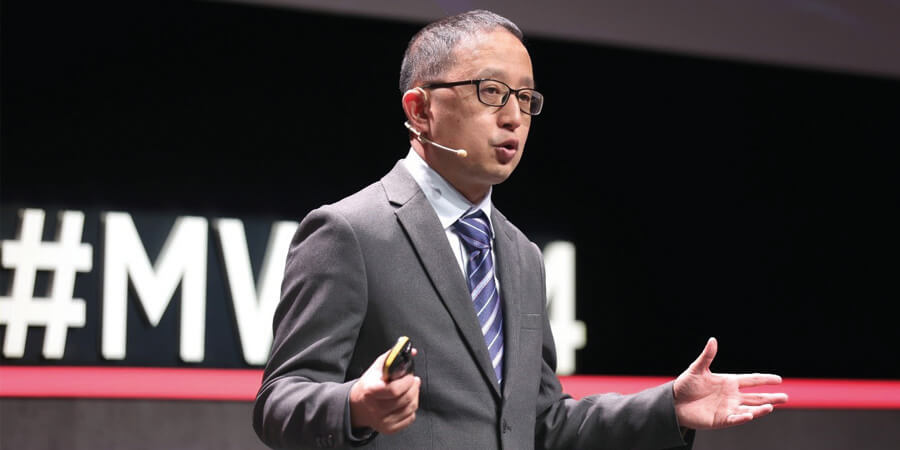During the Huawei Product & Solution Launch 2024 at the Mobile World Congress, Bruno Zhang, CTO of Huawei Cloud, gave a detailed presentation on how cloud and AI benefit the telecom industry at large.
Huawei Cloud: Systematic Innovation for AI
AI is becoming more and more important. Gartner predicts that by 2026, more than 80% of enterprises will use Generative AI capabilities, and that 70% of design and development will be significantly altered by Generative AI APIs. By 2028, 75% of software engineers will have used AI coding assistants.
“Huawei Cloud accelerates intelligence through systematic innovation; that means AI for Cloud and Cloud for AI,” said Zhang.
Within the realm of AI for Cloud, Huawei Cloud's Pangu models power intelligent upgrades of industries and cloud applications. Similarly, Huawei Cloud upgrades cloud services for AI by innovations such as a QingTian architecture, AI-native storage, data-AI convergence, and distributed cloud infrastructure. These advancements enable deployment and utilization across cloud, network, edge, and device environments. These include CloudOcean, CloudSea, CloudLake, CloudPond, and Huawei Cloud Stack.
Huawei Cloud Stack is the industry's first hybrid cloud for large models, offering tailored solutions for B2B carrier needs. “All of the foundation model capabilities can be deployed in your preferred mode, including public cloud, dedicated zone, and hybrid cloud,” said Zhang.
For example, telcos can build and run their dedicated AI platform and foundation models in their existing data centers using Huawei’s hybrid cloud solution.
Pangu Models: Reshaping the Telco Industry with AI
“Telcos are a big customer of Huawei Cloud Pangu models… We expect to reshape the telco industry with even more models,” highlighted Zhang. Huawei Cloud Pangu models can offer solutions for R&D, code production, as well as marketing and sales.
Huawei’s R&D model (CodeArts) helps telco developers generate code with just one prompt and test cases with just one click. Additionally, the telecom model automatically troubleshoots 90% of faults in just minutes for telco networks. This improves the production with intelligent-assisted O&M, optical network configuration, and package recommendation.
The virtual human model (Metastudio) boasts 95% lip sync accuracy, to be utilized in the telco customer service sector, and boasts the ability to converse with over 20 languages.
GaussDB: Distributed Database for Intelligent Telco Services
“To process data both efficiently and securely, telcos need a solid database,” pointed out Zhang. Huawei Cloud GaussDB is an enterprise-class distributed database that's widely used in finance, telecom, and government sectors with over 100,000 nodes.
To summarize, GaussDB is characterized by the following elements:
- High Availability: GaussDB ensures intra-city dual-cluster strong consistency with zero RPO, effectively meeting the high availability demands of telcos.
- High Security: GaussDB holds CC EAL4+ certification— the highest security level in the industry. Its highly secure source code makes up the fully-encrypted, anti-tamper database.
- High Performance: Utilizing the Ustore storage engine, GaussDB works in all-weather performance without jitters.
- High Scalability: To automate migration, GaussDB provides one-stop tools to convert 95% of common syntax to reduce the cost and improve the migration efficiency.
- High Intelligence: Through SQL audits and intelligent O&M, GaussDB exhibits intelligent database development.
DataArts: Data-AI Convergence
“Data is the key of foundation models. To develop telecom models, data from the BSS, OSS, and MSS domains needs to unify into one data lake for AI training. Huawei Cloud's data-AI convergence platform is a robust data foundation for these models,” Zhang expounded.
Telco large models face data challenges such as data silos, poor data quality, and training lags. In response, Huawei is converging warehouses and lakes with AI, resulting in higher efficiency (zero data migration), higher model accuracy (high quality and compliance), and real-time, data-driven online training and inference.
Zhang noted that through LakeFormation, one copy of data can be shared without migration; while the DataArts Studio makes the entire data governance process more intelligent, from data integration and development to quality and asset management. Working as a collaborative workbench, three pipelines— DataArts, ModelArts, and CodeArts— orchestrate and schedule data and AI workflows to drive online model training and inference with real-time data.
AI-Native Storage: EMS, SFS Turbo, and OBS
Following the utilization of Huawei’s AI-native storage, challenges such as NPU memory limitations for storing trillions of parameters, the warming up of 1 billion training metadata records within 100 hours, and the high costs associated with storing exabytes of data are effectively addressed.
“To train these models, we need exabytes of data. But where and how do we store that? We first offer a memory service called EMS. It stores petabytes of parameters with ultra-large bandwidth and ultra-low latency,” explained Zhang.
Huawei also offers SFS Turbo cache services with high throughput and concurrency. Consequently, tens of millions of IOPS are achieved, and 1 billion metadata records are warmed up in just five hours.
Finally, a knowledge lake built on Object Storage Service reduces the cost of storing training and inference data by 30%. These include deep archive, intelligent tiering, and StorageLens.
Cloud on Cloud: Enabling Carriers in Cloud and Intelligent Upgrades
For carriers who want to build their own cloud services under their own brand, Huawei’s Cloud on Cloud solution covers professional consulting, end-to-end operations, and one-stop migration services.
“We share our tech through 150,000 industry APIs. We share our experience in serving more than 3 million business customers. And we share our ecosystem through numerous KooGallery offerings,” Zhang emphasized. “All of these efforts aim to help carriers quickly build B2B services and seize opportunities in intelligent upgrades.”
In closing, Zhang encouraged everyone to explore the Huawei Cloud. “We look forward to joining you on this cloud journey,” he concluded.





